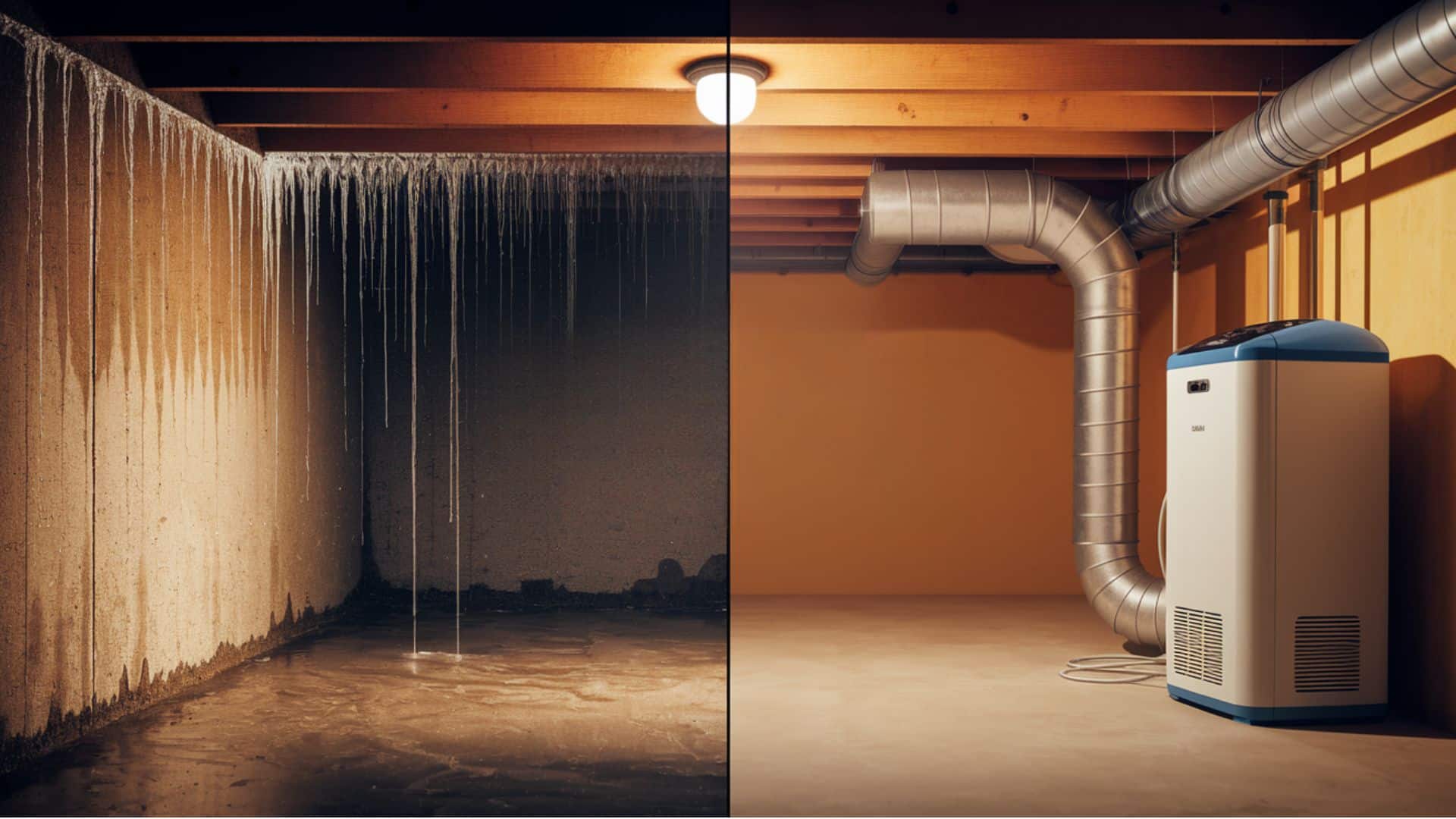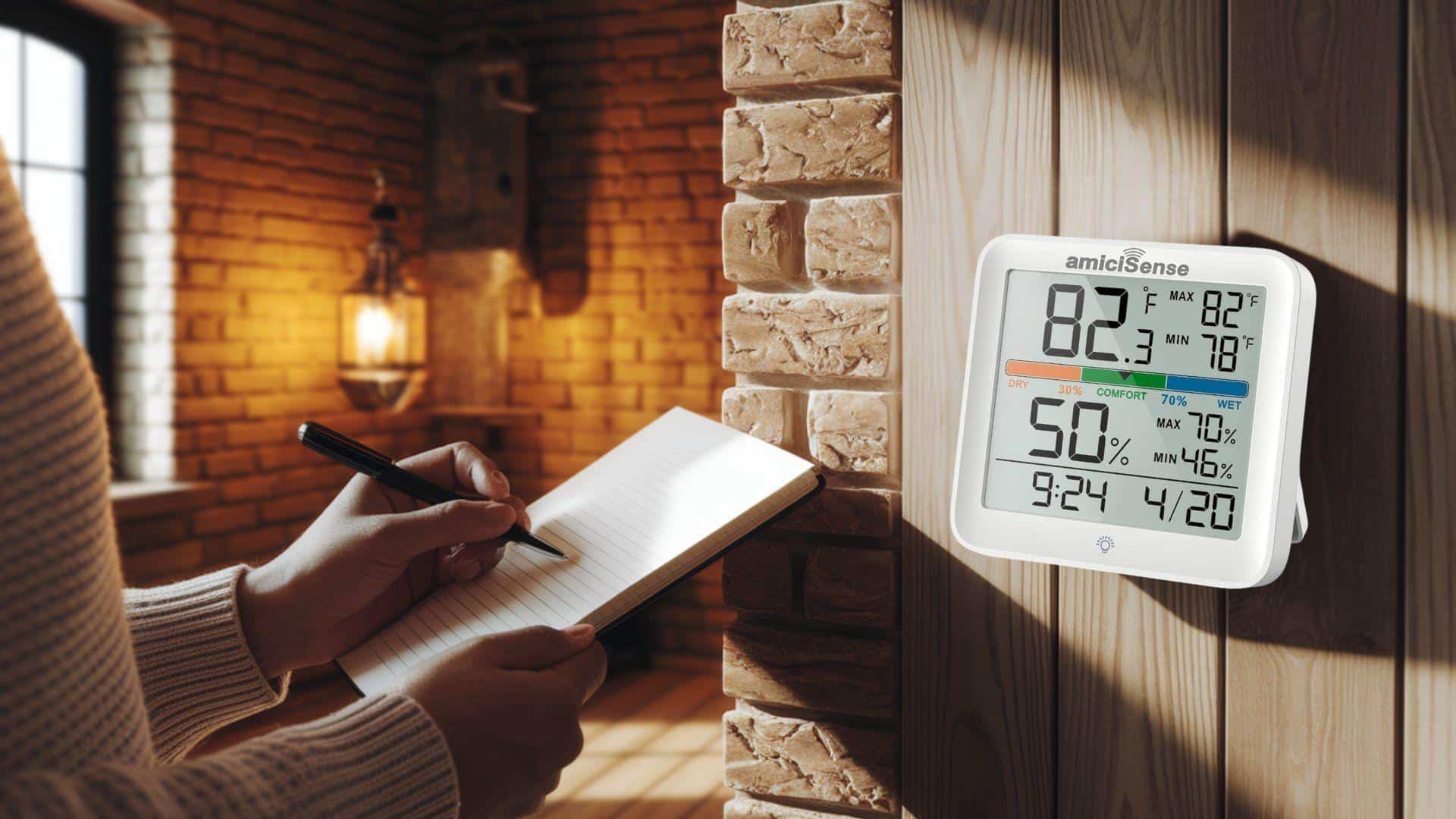Did it happen to you when the musty smell hits you every time you walk downstairs? Your basement feels sticky and damp, making storage a nightmare and creating perfect conditions for mold growth.
High humidity levels above 60% can damage your belongings, trigger health problems, and even weaken your home’s foundation over time.
I’ve helped hundreds of homeowners fix their basement humidity problems using simple, proven methods that work in any climate. These techniques can drop your humidity levels to the ideal 30-50% range within weeks.
Let me show you exactly how to measure, identify causes, and fix basement humidity issues using four practical strategies that protect both your health and your home’s value.
What is Basement Humidity?
Basement humidity refers to the amount of water vapor present in your basement’s air.
Relative humidity measures this as a percentage; it shows how much moisture the air holds compared to the maximum it can contain at that temperature.
When your basement feels damp or sticky, you’re experiencing high humidity levels.
Basements face unique moisture challenges that make them humidity hotspots. Their below-ground location means they’re surrounded by soil that holds water, especially after rain or snow.
Poor air circulation makes the problem worse since stagnant air can’t carry moisture away effectively. Common moisture sources include:
- Foundation leaks from cracks or poor waterproofing
- Condensation on cold walls and pipes
- Groundwater seepage through concrete floors
- Inadequate ventilation that traps humid air
- Appliances like washers, dryers, and water heaters
The ideal basement humidity range is 30% to 50%. This sweet spot prevents mold growth while keeping the space comfortable.
Humidity below 30% can cause wood to crack and create static electricity. Above 50% promotes mold, mildew, and dust mites, creating health risks and structural damage.
Signs of High Humidity in the Basement
1. Musty, moldy odors: Strong, unpleasant smells that greet you every time you enter your basement, indicating mold and mildew growth from excess moisture in the air.
2. Condensation droplets: Water beads forming on cold surfaces like walls, pipes, windows, and metal objects, showing that humid air is meeting cooler temperatures and releasing moisture.
3. Visible mold spots: Dark, fuzzy patches appearing on walls, ceiling tiles, stored boxes, or fabric items, thriving in the damp conditions created by high humidity levels.
4. Damp, sticky feeling: The air feels heavy and uncomfortable against your skin, making the basement space unpleasant to spend time in or use for storage purposes.
5. Water stains: Discolored patches on walls, floors, or foundation surfaces that show where moisture has accumulated, dried, and left behind mineral deposits or damage marks.
How to Measure Basement Humidity?
Measuring basement humidity accurately requires the right tools and proper technique.
A digital hygrometer provides more reliable readings than analog versions. Place the device in the center of your basement at eye level, away from walls, vents, or moisture sources, such as water heaters.
Wait 24 hours before taking your first reading to allow the instrument to adjust to basement conditions.
Regular monitoring is key to maintaining healthy humidity levels. Take readings at different times throughout the day, as humidity fluctuates with temperature and changes in weather.
Record weekly measurements to track patterns and identify problem periods when humidity spikes occur.
Understanding your readings helps you take proper action:
- 30-50% humidity indicates optimal, healthy conditions.
- Above 60% requires immediate attention to prevent mold growth.
- Below 30% may cause wood cracking, but it is rare in basements.
- Sudden spikes often signal new leaks or ventilation problems.
Keep a log of your measurements along with weather conditions and any basement activities like laundry or cooking. This data helps you identify trends and determine when your humidity control methods need adjustment.
Causes of High Basement Humidity
High basement humidity stems from multiple sources that work together to create moisture problems. Understanding these causes helps you identify and fix the root issues affecting your space.
1. External Water Sources
Water from outside your home creates the most significant humidity problems in basements. These external factors bring moisture directly into your foundation area.
- Heavy rainfall pushes water through saturated soil, creating hydrostatic pressure that forces moisture through your foundation walls and into the basement space.
- Melting snow adds extra water volume to the soil around your home, increasing pressure against basement walls during spring thaw periods.
2. Internal Moisture Sources
Daily household activities generate water vapor that naturally settles in your basement’s cooler air. These internal sources often go unnoticed but contribute significantly to humidity problems.
- Cooking and showering activities upstairs release steam and water vapor that flows downward through your home, settling in the coolest area.
- Laundry activities, including washing clothes and running dryers, add substantial moisture to basement air, especially when venting systems function poorly.
3. Structural and Building Issues
Problems with your home’s construction and maintenance create pathways for moisture entry while preventing proper moisture removal. These structural issues require targeted repairs.
- Wall cracks in foundation concrete or masonry allow water infiltration during heavy rain, snow melts, and periods of high groundwater.
- Poor foundation sealing allows moisture to pass through porous concrete and masonry materials, creating constant humidity sources inside your basement.
Risks of Basement Humidity Levels
Excessive basement humidity can create serious problems that affect both your health and your home’s structural integrity. These issues develop gradually but can cause lasting damage if left untreated.
Health Concerns
Mold and mildew thrive in humid environments, releasing spores that trigger respiratory problems. High humidity levels above 60% create perfect breeding conditions for these harmful microorganisms. Health impacts include:
- Asthma attacks and breathing difficulties
- Allergic reactions like sneezing and watery eyes
- Chronic coughing and throat irritation
- Skin rashes and irritation
- Weakened immune systems in vulnerable individuals
Pest Infestations
High humidity attracts unwanted pests who need moisture to survive. Dust mites multiply rapidly in humid conditions, worsening allergies. Termites and carpenter ants target moisture-damaged wood. Silverfish and centipedes seek out damp, dark spaces for breeding.
Strategies to Control Basement Humidity
Effective basement humidity control requires combining multiple approaches to address both moisture sources and air quality. These four key strategies work together to maintain optimal humidity levels.
| Strategy | Methods | Best For | Maintenance |
|---|---|---|---|
| Dehumidifiers | Refrigerant, desiccant, portable units | Active moisture removal | Empty tanks, clean filters monthly |
| Ventilation | Exhaust fans, windows, and air circulation | Fresh air exchange | Clean fans seasonally |
| Waterproofing | Seal cracks, waterproof coatings, and sump pumps | Stop water infiltration | Check cracks annually, and test pumps |
| Drainage | Proper grading, gutters, and downspouts | Exterior water control | Clean gutters twice yearly |
Start with a dehumidifier for immediate results, then address structural issues like waterproofing and drainage for long-term humidity control.
Conclusion
Reducing basement humidity effectively comes down to understanding your specific moisture sources and taking targeted action.
By measuring humidity levels regularly, addressing water infiltration issues, and using the right combination of dehumidifiers and ventilation, you protect both your family’s health and your home’s structural integrity.
Remember that musty basement smell I mentioned at the start? It doesn’t have to be permanent. These proven strategies work for basements in any climate when applied consistently.
Start by getting a digital hygrometer today to measure your current humidity levels. Once you know your baseline, pick the most pressing issue from this guide and tackle it first. Small steps now prevent expensive repairs later.
What’s your biggest basement humidity challenge?










